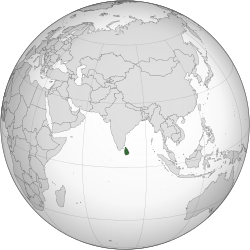Ceylon[1] | |||||||||
|---|---|---|---|---|---|---|---|---|---|
| 1948–1972 | |||||||||
| Anthem: Sri Lanka Matha (1951–1972) | |||||||||
 | |||||||||
| Capital and largest city | Colombo 6°56′04″N 79°50′34″E / 6.93444°N 79.84278°E | ||||||||
| Common languages | Sinhala Tamil English | ||||||||
| Religion |
| ||||||||
| Demonym(s) | Ceylonese | ||||||||
| Government | Unitary parliamentary constitutional monarchy | ||||||||
| Monarch | |||||||||
• 1948–1952 | George VI | ||||||||
• 1952–1972 | Elizabeth II | ||||||||
| Governor-General | |||||||||
• 1948–1949 | Sir Henry Monck-Mason Moore | ||||||||
• 1949–1954 | Lord Soulbury | ||||||||
• 1954–1962 | Sir Oliver Ernest Goonetilleke | ||||||||
• 1962–1972 | William Gopallawa | ||||||||
| Prime Minister | |||||||||
• 1948–1952 | D. S. Senanayake | ||||||||
• 1952–1953 | Dudley Senanayake | ||||||||
• 1953–1956 | Sir John Kotelawala | ||||||||
• 1956–1959 | S. W. R. D. Bandaranaike | ||||||||
• March 1960 – July 1960 | Dudley Senanayake | ||||||||
• July 1960–1972 | Sirimavo Bandaranaike | ||||||||
| Legislature | Parliament of Ceylon | ||||||||
| Senate | |||||||||
| House of Representatives | |||||||||
| History | |||||||||
| 4 February 1948 | |||||||||
• Republic | 22 May 1972 | ||||||||
| Area | |||||||||
| 1956[2] | 65,610 km2 (25,330 sq mi) | ||||||||
| Population | |||||||||
• 1956[2] | 8,104,000 | ||||||||
| Currency | Ceylon Rupee | ||||||||
| |||||||||
"Sri Lanka". Retrieved 30 March 2010. | |||||||||
| Historical states of Sri Lanka |
|---|
 |
Ceylon[1][3] was an independent country in the Commonwealth of Nations from 1948 to 1972, that shared a monarch with other dominions of the Commonwealth. In 1948, the British Colony of Ceylon was granted independence as Ceylon. In 1972, the country became a republic within the Commonwealth, and its name was changed to Sri Lanka.
- ^ a b The Sri Lanka Independence Act 1947 uses the name "Ceylon" for the new dominion; nowhere does that Act use the term "Dominion of Ceylon", which although sometimes used was not the official name.
- ^ a b Havinden, Michael A.; Meredith, David (1 June 2002). Colonialism and Development: Britain and its Tropical Colonies, 1850–1960. Routledge. p. 9. ISBN 978-1-134-97738-3.
- ^ International treaties Archived 21 March 2017 at the Wayback Machine also referred to the state as "Ceylon", not the "Dominion of Ceylon"; "Ceylon" was also the name used by the UN for the state.


